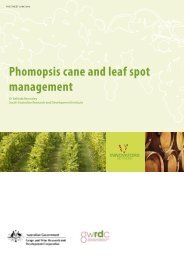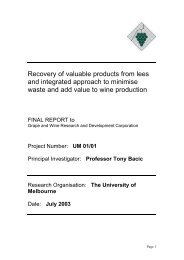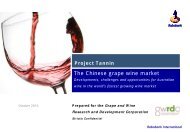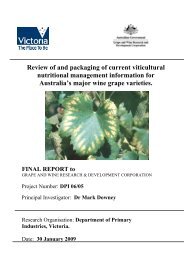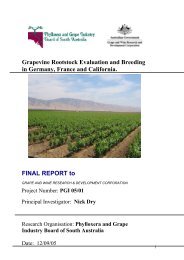Identification of the major drivers of 'phenolic' taste in ... - GWRDC
Identification of the major drivers of 'phenolic' taste in ... - GWRDC
Identification of the major drivers of 'phenolic' taste in ... - GWRDC
Create successful ePaper yourself
Turn your PDF publications into a flip-book with our unique Google optimized e-Paper software.
AWRI: <strong>Identification</strong> Of The Major Drivers Of ‘Phenolic’ Taste In White W<strong>in</strong>es<br />
Table 2-1: Somers’ measurments for 2009 experimental w<strong>in</strong>es (Mean <strong>of</strong> duplicate spectral<br />
measurements for each w<strong>in</strong>e triplicate ferment, Standard errors <strong>in</strong> paren<strong>the</strong>ses).<br />
Press fraction/f<strong>in</strong><strong>in</strong>g rate Total Phenolics (au) Total HCA (au) Flavonoid Extract.<br />
Free Run (FR) 5.97 (0.086) 6.35 (0.114) 1.75 (0.016)<br />
Light press<strong>in</strong>gs (LP) 10.19 (0.004) 10.85 (0.004) 2.97 (0.004)<br />
Heavy press<strong>in</strong>gs (HP) 10.22 (0.029) 8.39 (0.024) 4.63 (0.012)<br />
HP + 200 ppm Liquif<strong>in</strong>e 9.66 (0.008) 8.04 (0.008) 4.30 (0.004)<br />
HP + 1000 ppm Liquif<strong>in</strong>e 9.34 (0.016) 7.80 (0.016) 4.14 (0.004)<br />
The consensus view amongst <strong>the</strong> experienced w<strong>in</strong>emaker panel was that ‘phenolic <strong>taste</strong>’ was a<br />
multivariate sensory attribute that comprised aspects <strong>of</strong> bitterness, astr<strong>in</strong>gency (or ‘grip’), and<br />
oil<strong>in</strong>ess/viscosity. Some <strong>taste</strong>rs also suggested that high phenolic w<strong>in</strong>es displayed a specific flavour<br />
character but were unable to adequately describe it. O<strong>the</strong>rs felt that some phenolic w<strong>in</strong>es also<br />
displayed hotness or burn<strong>in</strong>g sensation experienced at <strong>the</strong> back <strong>of</strong> <strong>the</strong> throat that detracted from overall<br />
w<strong>in</strong>e quality.<br />
Table 2-2: Rank totals <strong>of</strong> perceived ‘phenolic <strong>taste</strong>’ (lower rank total implies higher <strong>in</strong>tensity).<br />
Treatment Free Run Light Press<strong>in</strong>gs Heavy Press<strong>in</strong>gs p LSD<br />
Rank totals 32 a 22 b 18 b 0.013 9.6<br />
Treatment HP HP200G HP1000G p LSD<br />
Rank totals 21 a 27 a 24 a 0.472 n/a<br />
S<strong>in</strong>gleton et al. (1975) fermented six different white grape varieties on total sk<strong>in</strong>s for one to five days<br />
before separat<strong>in</strong>g <strong>the</strong> sk<strong>in</strong>s from <strong>the</strong> ferment<strong>in</strong>g must. The result <strong>of</strong> this highly unconventional white<br />
w<strong>in</strong>emak<strong>in</strong>g practice was to double total phenolics after five days <strong>of</strong> maceration. Mak<strong>in</strong>g white w<strong>in</strong>e<br />
as one would a red w<strong>in</strong>e represents an extreme variant <strong>of</strong> traditional white w<strong>in</strong>emak<strong>in</strong>g with <strong>the</strong><br />
potential to maximise total phenolic content. So although it was shown that both <strong>the</strong> astr<strong>in</strong>gency and<br />
bitterness <strong>of</strong> <strong>the</strong> w<strong>in</strong>es were moderately correlated with total phenolic content by an expert tast<strong>in</strong>g<br />
panel, <strong>the</strong> practical relevance <strong>of</strong> <strong>the</strong> results rema<strong>in</strong> <strong>in</strong> question.<br />
In this study, <strong>the</strong> w<strong>in</strong>es be<strong>in</strong>g compared were a reasonable representation <strong>of</strong> commercial white<br />
w<strong>in</strong>emak<strong>in</strong>g practice. Despite be<strong>in</strong>g unable to fully agree as to <strong>the</strong> nature <strong>of</strong> ‘phenolic <strong>taste</strong>’ <strong>in</strong> white<br />
w<strong>in</strong>e, <strong>the</strong> experienced w<strong>in</strong>emakers were able as a group to differentiate <strong>the</strong> more phenolic w<strong>in</strong>es made<br />
from light and heavy press<strong>in</strong>g juices from <strong>the</strong> free run w<strong>in</strong>e (Table 2-2). They were unable to<br />
Page | 23




